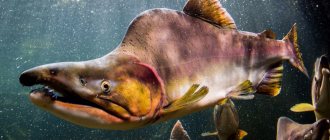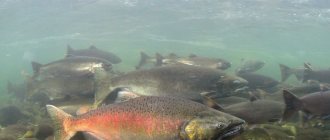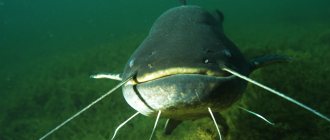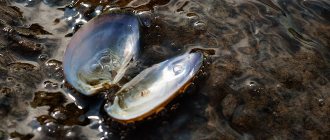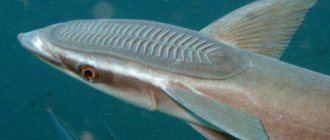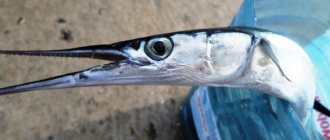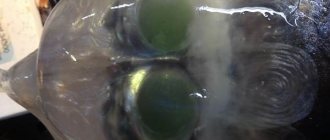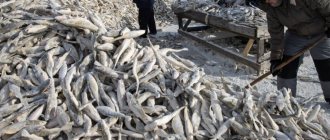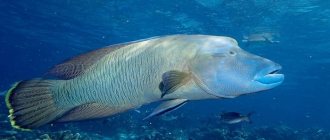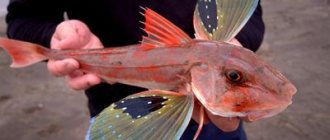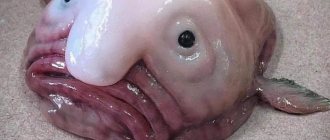Arapaima gigantea
Arapaima ( Arapaima gigas, piraruku) is a living fossil, the same age as the dinosaurs of the Jurassic period of the Mesozoic era, a unique creature that has survived to this day in exactly the same form as 135 million years ago. Who are we talking about? About one of the rarest and most unusual inhabitants of private and public aquariums, about the fish that the Indians of Peru and Guyana call pirarucu, about the largest freshwater fish in the world - about the arapaima or giant arapaima. Yes, no matter how strange it may sound, such monsters sometimes become aquarium pets.
Arapaima, which lives in quiet shallow pools, swampy tributaries and oxbow lakes of the Amazon, first appeared in scientific documents in 1822. For the unusual red-orange color of the delicious meat and contrasting red spots on the scales, the South American Indians nicknamed this fish pirarucu - red fish. For many, many years, the pirarucu was the main hunting object and source of food for the indigenous people of the Amazon. Today, the arapaima, although it has no natural enemies, is a rare fish, its population has greatly decreased, it is protected by law and the catching of pirarucu is strictly regulated, which, in principle, does not particularly concern the local Indians. Arapaima gigantea is unique in everything. For example, it belongs to the Arowana family, the genus Arapaima, in which there is only one species - Arapaima gigantea. That is, in the international zoo classification she has no close relatives!
Piraruca was not called a giant for nothing - in nature this fish reaches a modest three meters in length and two centners of weight! According to unverified data, adult individuals of arapaima have been encountered that have reached almost four meters and about three hundred kilograms, but this fact has no documented confirmation.
Arapaima photo
The appearance of the arapaima literally screams about its ancient origin - something between a predatory fish and a reptile: an elongated, streamlined body with a small flattened head and a huge powerful mouth with many sharp, long and strong teeth. The body is covered with large scales, which are more reminiscent of medieval plate armor, and are stronger than bone, which allowed the pirarucu to adapt to its absolutely safe neighborhood with piranhas. The pectoral “steering” fins of the arapaima are well developed, located in the usual place, in contrast to the dorsal and anal fins, which are strongly shifted towards the tail.
The caudal fin is modest in size, but in combination with the dorsal and anal fins it creates a powerful thrust, allowing this rather large fish to develop enormous speed. A striking distinctive feature of the pirarucu is the fins of the pelvic girdle, which have not become rudiments over millions of years, with the complete absence of the pelvic fins familiar to the eye! The color of the giant arapaima is also unusual - on the gray-silver scales closer to the tail and along the belly there are bright, contrasting red spots and veins. It gives the impression of lava cooling on the surface of a volcano after an eruption.
Arapaima photo
The giant arapaima is a predator that is constantly on the move and searching for food. This fish often prefers the bottom layer of water, spending most of its time at the bottom of oxbow lakes and swampy pools of the Amazon, but it hunts both in the bottom layer and at the very surface. The object of arapaima's hunting is most often small and medium-sized fish, mollusks and invertebrates, small reptiles, as well as rodents and small mammals and even birds. Pirarucu is a dangerous and tireless hunter; this fish can pursue its prey for a long time and persistently, and when hunting a bird or rodent, it jumps out of the water for almost the entire considerable length of its body.
The swim bladder and part of the arapaima's pharynx are covered with pulmonary tissue, very similar in structure to the lungs of mammals and reptiles, which allows the giant arapaima to breathe atmospheric air. Due to the meager oxygen content in the arapaima's swampy habitat, this giant comes to the surface every 15-20 minutes for a portion of oxygen, noisily exhaling exhaust air. Local Indians take advantage of this feature by throwing sharpened darts into circles on the surface of the water in the hope of hitting a huge fish.
Size and appearance
Arapaima (“Arapaima gigas”) is an ancient freshwater ray-finned fish from the Aravanidae family of the Aravanidae order. Representatives of Indian tribes call arapaima “piraruca”, which means “red fish”. The reason for this was the orange tint of the meat, as well as large reddish spots on the scaly cover and unpaired fins.
The giant arapaima is a large fish, slightly smaller in size than some beluga species.
The average length of an adult is 2–3 m. Pirarucu also weighs a lot: the weight of one such fish can reach 150–200 kg.
Experts talk about the existence of larger specimens: science knows of cases where in the Amazon basin local fishermen caught fish 4.5 m long. However, the description was compiled from the words of local residents and did not have documentary evidence.
The arapaima's body, covered with red and brown scales, is elongated and laterally compressed. The belly, like most fish, is rounded.
The head is medium-sized, elongated and thick in the upper part, covered with durable bone plates that form a unique pattern (this can be seen in the photo).
Large bulging eyes are located on both sides of the head in the lower half of the muzzle.
The mouth is wide and located at the top. The jaw is equipped with two types of teeth: some, like most fish, are located on the palate, and others, similar to hard growths, are located on the tongue. The head of the arapaima is olive-brown in color, with reddish spots clearly visible on the gill covers.
A characteristic feature of the species is its interesting color: the front part of the fish’s body is brown-gray with a green tint, closer to the dorsal fin the color gradually turns red, and towards the tail it becomes burgundy. The composition is completed by a dark wide stripe in the tail area.
The fins of the arapaima are large and powerful. The dorsal is located in the back of the body closer to the tail directly above the anal. Combined with the caudal fin and a powerful, bilaterally compressed caudal peduncle, the dorsal fin forms an impressive paddle, which helps the arapaima develop speed and jump out of the water while chasing prey or escaping enemies. In the lower part of the body, almost at the very abdomen, the pectoral fins are located.
These fish have highly developed sexual dimorphism: at sexual maturity, arapaima males are larger than females and have brighter colors. Young males and females have a uniform, uniform color and are practically indistinguishable from each other.
Features of scales
The body of arapaima, as can be seen in the photo, is covered with durable and large relief scales. According to available data, the strength of scales is several times greater than the strength of bones. Thanks to this, the pirarucu feels great in the company of piranhas, with whom it sometimes has to coexist in small bodies of water that are separated from the large river during drought.
General information
Unfortunately, the lifestyle of these ancient freshwater animals has been practically not studied. The main sources of information are various narratives of tourists, which are often unreliable. Local residents, who have been fishing arapai for many years, have not carried out any scientific research. The Indians saw the “red fish” only as a source of food.
The Latin name "Arapaima gigas" was formed by combining several words from different languages. The people of Peru called the fish arapaima or arapaima. "Gigas" means "giant" in Latin. Other names, pirarucu and paiche, may have come from one of the local dialects.
This fish lives in water bodies
Habitat and lifestyle
In nature, the ancient pirarucu lives in South America - in countries located off the coast of the Amazon: Peru, Brazil, Guyana. Some time ago, this fish was moved from the Amazon to artificial and natural reservoirs in Malaysia, as well as Thailand, where local specialists are breeding it on an industrial scale.
Arapaima is a bottom-dwelling fish that thrives in algae-covered lake and river backwaters with warm water (26–29 degrees). Sometimes you can find it in large swamps, as well as ponds overgrown with mud. During the rainy season, representatives of this species often move from the river to floodplain forests flooded with water, and after it disappears they return to the river backwater.
Pirarucu is a predator that prefers not to hunt, tracking prey from cover, but to find and pursue it, being in constant motion. In the process of searching for food, the fish can float to the surface, and sometimes jump out of the water (often showing itself in all its glory), which gives it the opportunity to hunt not only suitable-sized fish and shellfish, but also snakes, waterfowl or animals that come to drink and birds flying past.
They say that the favorite “delicacy” of the arapaima is its distant “relative” the arawana, which is significantly smaller in size. This fact has no scientific evidence, because it is very difficult to describe the life of arapaima, which lives in hard-to-reach places.
The fish is allowed to float to the surface and inhale atmospheric air by an additional respiratory organ, which is a special tissue densely covered with a capillary network, similar to the lung. This tissue lines the cavity of the pharynx and swim bladder. In addition to the ability to catch an animal or bird, this feature of the internal structure helps the arapaima survive in the Amazon, whose water contains insufficient oxygen.
Thanks to the ability to breathe ordinary air, arapaima easily tolerates drought, which in tropical countries often comes after the rainy season. When there is little water in a river or lake, the fish floats to the surface, swallows air, and then buries itself in wet river sand or silt. True, she has to perform such manipulations every 5–20 minutes.
Arapaima breathes so loudly that the sound of the air it swallows can be heard over a radius of several kilometers.
There is no exact answer to the question of how many years an arapaima can live in the wild. According to some reports, given favorable conditions, the life expectancy of this fish can be about 20 years.
Natural enemies
By nature, the arapaima fish is equipped with an excellent defense system. It is difficult to say who can cope with this strong and powerful creature. Some claim that there have been recorded cases of alligators attacking giant fish. But these precedents are extremely rare.
For some time, piranhas were considered natural enemies. But this statement is erroneous. Piranhas cannot cope with arapaima scales.
Due to its body size and scale armor, the arapaima rarely becomes a victim of attacks. The only enemy of this amazing creature is man. For residents of South America, hunting arapaima was a completely common, everyday activity.
“Amazonian Indians still consider arapaima red meat dishes to be their main delicacy.”
They catch giant fish using a harpoon or a net, which, thanks to centuries of practice, they do masterfully. To catch the creature, there are certain schemes developed over many years of fishing.
Fishermen are well aware of the nuances of the creature's respiratory system. They easily calculate at what moment the fish will appear on the surface of the water. The signal for them is the characteristic sound that an individual makes when capturing air.
Arapaima are caught in small lakes and reservoirs.
Arapaima meat is quite valuable and has a high price. It contains many nutrients. Fish bones can be used for medical and household purposes.
Yandex pictures
Captivity
Piraruca is often kept in captivity. Due to the good taste of the meat, it is used as an object of industrial fish farming, grown in artificially created reservoirs.
It’s a stretch to call pirarucu an ornamental fish, but it attracts the attention of visitors with its impressive size. That is why arapaima can be seen in zoos, public and amateur aquariums.
Keeping predatory fish in captivity is quite difficult, because for the normal functioning of this mobile individual, a truly huge reservoir with water of a certain temperature is needed.
For keeping and breeding arapaima, large pools or aquariums with a capacity of at least 1000 liters are used. at a water temperature of 26–29 degrees. A prerequisite for keeping fish in captivity is regular aeration, filtration and replacement of water in the tank.
Arapaima is included in the list of heat-loving fish, so a drop in temperature of more than 5 degrees can be disastrous for it.
In captivity, the diet of pirarucu is almost the same as in natural conditions: the fish are fed protein foods (beef, offal, poultry, fish, shellfish, etc.). Given the predator’s tendency to get food on the move, small fish must be introduced into the pool or aquarium.
An adult arapaima is fed once, and young animals are fed at least 3 times a day. Feeding is carried out strictly according to schedule. If the fish does not receive food on time, it may attack its relatives.
In captivity, arapaima grows to an average height of 1.5 meters and lives for about 10 years.
Sometimes other large fish can peacefully coexist in the same aquarium or pool with pirarucu.
Features of fishing
Fish are actively bred in artificial conditions. There are paid artificial reservoirs where paid fishing is offered. The procedure requires preparation; large fish can tear out the gear.
How to find. Spreading
The giant arapaima lives in the waters of the Amazon. The fish has taken root well in Thailand and Malaysia, where it was introduced artificially. In wildlife, the predator prefers river backwaters, lakes, and floodplain reservoirs. The optimal temperature is considered to be 25-29 degrees. During the rainy season, she goes to the forest creeks.
Behavioral Traits
Arapaima feeds on other fish, animals, and birds that come within its reach. Predator every 15-20 minutes. floats to the surface of the reservoir to inhale air. This moment is a turning point for fishermen. The locals immediately start shooting arrows from their bows. Many arrows pierce the flesh of the predator every time it appears on the surface.
Fishing season
The fishing season is between July and November. During this period, women prepare food for the year.
Fishing methods
When choosing gear, preference should be given to conventional tools.
Tackle:
- live bait float tackle;
- spinning;
- casting equipment;
Local fishermen use harpoons, nets, bows and arrows when catching arapaima.
Tackle
Strong two-meter rods with a test weight of 40-100 g will help you catch a large predator.
The following equipment is used for rigging:
- power multiplier reel, line capacity of the spool is 100 m, line 2 mm;
- main line – braided cord/monofilament line 2 mm;
- strong, sharp treble hooks (Owner, Mustad).
There is no need to use leashes.
How to catch, bait
Small fish and crustaceans should be used as bait.
The following types of artificial baits show high efficiency:
- oscillating spoons;
- wobblers;
- braided flies.
braided fly
is a prohibited fish. You can recognize its presence by its loud sound. At this moment you should throw the bait into the water. The predator reacts instantly. Large fish can tear off the gear and break the spinning rod. The rig must be strong enough to withstand the first tug. The fish is large in size; it is necessary to prepare in advance for its catch and export.
Reproduction and offspring
Arapaima becomes sexually mature in the fifth year of life. The length of the fish that goes to spawn for the first time is 160–200 cm. Arapaima eggs are laid in early spring.
For spawning, pirarucu chooses shallow areas of the river with clean, slowly flowing or standing water and a sandy bottom. A female preparing to reproduce offspring builds a so-called nest - she forms a hole in the sand about 60–80 cm wide and about 20 cm deep. She lays eggs in this hole. Then the male takes care of the offspring, conscientiously guarding the rather large eggs, and then the fry, which appear approximately 2 days after spawning. At this time, the female does not remain idle either, diligently patrolling the area within a radius of 10–15 m from the nest with offspring.
The fry, hatched from the eggs, stay close to the male’s head for the first few days and feed on a white secretion secreted by special glands located behind his eyes.
Arapaima babies grow quickly, gaining about 5 cm in length and about 100 g in weight per month. Almost immediately after the yolk sac resolves (about a week), they become the same predators as their parents and begin to obtain food on their own. At first, their diet consists of plankton and small invertebrates. Growing up, arapaima fry begin to hunt for small, and then for larger fish and other species of the animal world.
Despite the rapid growth of the fry and their relative independence, parents do not let their children out of sight for another 3 months. Experts explain this by the fact that until this time the young animals do not feel the presence of an additional respiratory organ and do not know how to use it. The male and female do not leave the babies until they learn to breathe atmospheric air.
Piraruku vulnerability
The “pulmonary” respiratory system of this fish is so specific that it made it quite vulnerable. The sound that is made when the mouth opens is a signal to fishermen.
If arapaima swims to the surface, then the water surface begins to resemble a whirlpool. The fishermen immediately notice him and throw a sharp harpoon into the center of the whirlpool. It's not always possible to hit the fish.
Having emerged from the center of the whirlpool with its mouth wide open, the piraruku releases “recycled” oxygen with a sharp sound, immediately inhales and immediately closes its mouth, sinking to the bottom. This lasts no more than 2-3 seconds.
This fish has a vulnerability
Anglers prefer to catch arapaima in small (no more than 120 meters in size) lakes, where it is quite easy to notice whirlpools. And at a certain moment, fishermen may be lucky - they will fall into the body of a fish that has risen to breathe air.
What does arapaima eat?
Arapaima is a predatory fish. If you look at its skeleton, you will notice a strong skull and a powerful rear part of the body with crowded unpaired fins. The role of this crowding was mentioned above as an “oar” that gives acceleration to the fish when attacking.
Juveniles feed mainly on freshwater shrimp. As they grow older, fish and even small animals, such as birds, are added to the arapaima's diet. Arapaima spends most of its time at the bottom, so the main part of its menu consists of bottom-dwelling fish. In general, there is no complete picture of the nutrition of these huge fish due to poor knowledge of the species.
Thanks to artificial breeding of arapaima in the countries of Southeast Asia, tender fish meat is supplied to many restaurants around the world. Unfortunately, uncontrolled fishing in their historical homeland has led to a significant reduction in populations and in some regions, it became necessary to include the species in the Red Book.
Breathing atmospheric air
Living in water bodies with oxygen deficiency is possible due to the special structure of the fish’s swim bladder, which performs the functions of a lung:
- The swim bladder is very large.
- The walls of the bladder are formed by cellular tissue, in which there is a dense network of blood vessels.
The arapaima's gill respiration provides only a fifth of its oxygen needs; it receives the remaining 80 percent of the required oxygen from atmospheric air. For this purpose, adult fish are removed every 15 minutes. floats up to the surface of the water. Young individuals need to rise for air more often.
Sticking its head out of the water and opening its mouth wide, the fish makes a peculiar clicking sound, releasing air from its swim bladder and drawing in the next portion.
More on the topic: 15 real creatures caught in rivers around the world
Reproduction
The breeding and reproduction of arapaima in pond farms and artificial reservoirs is carried out in different places on the Earth:
- It is bred in Thailand, where it was brought for the purpose of cultivation as an object for sport fishing. Fishing on the lakes is a very popular activity among tourists.
- In Peru, some reservoirs are protected to organize the breeding of arapaima in them in order to study its biology.
- In Brazil, arapaima were introduced into special ponds with the prospect of studying it.

